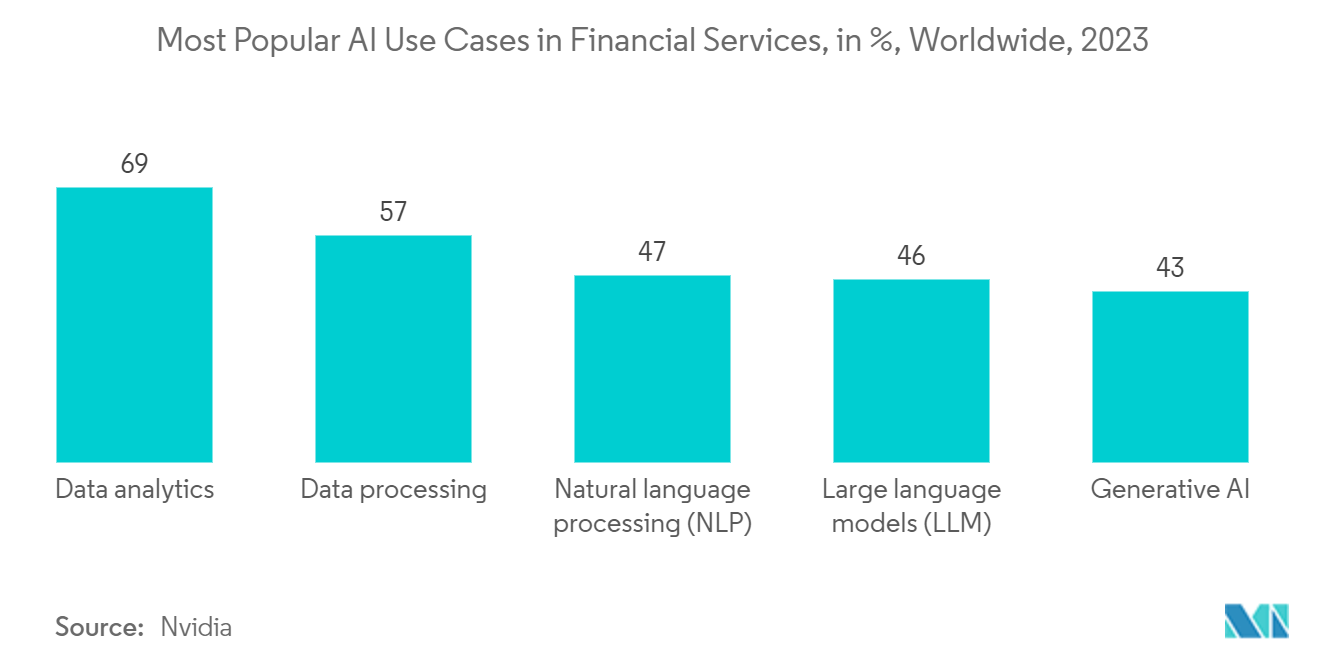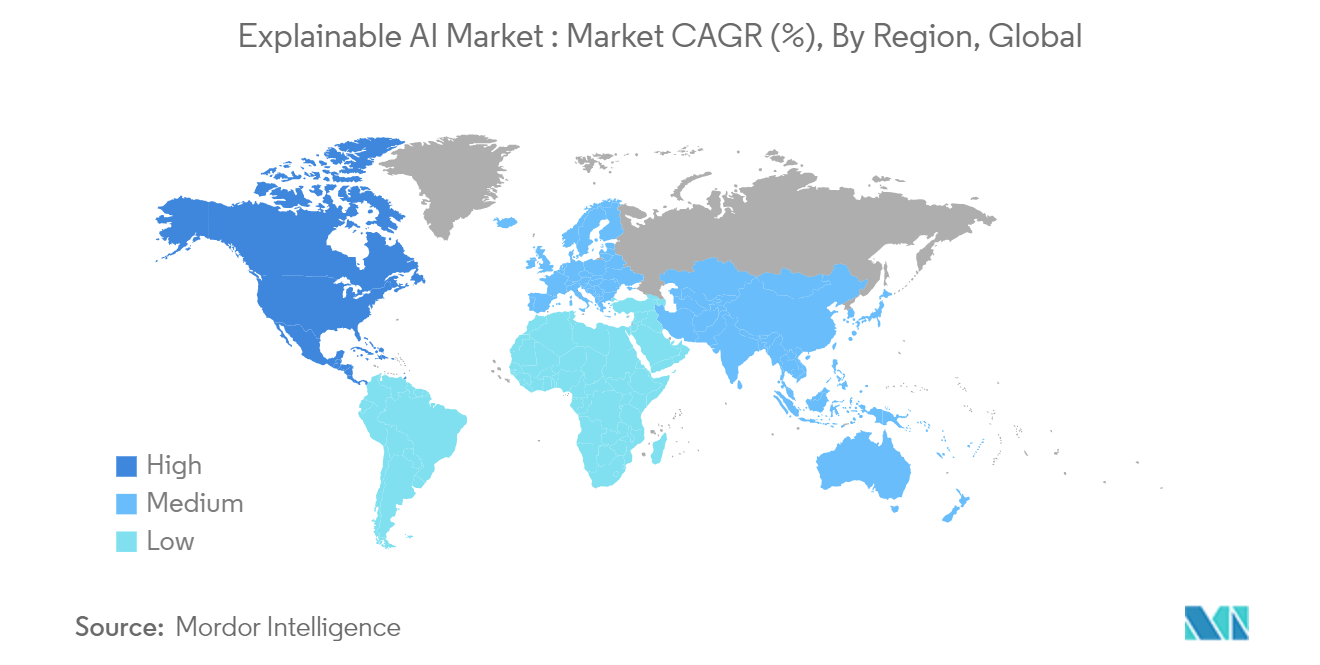Market Trends of Explainable AI Industry
BFSI Segment is Expected to Hold Significant Share of the Market
- The emerging field of XAI can enable banks to navigate such transparency and trust issues and provide greater clarity on AI governance. Due to insufficient customer onboarding processes, financial institutions lose millions of dollars. It becomes difficult for many banks to evaluate their health by applying for a loan. Explainable AI provides a system for eligibility checks and risk management while maintaining transparency. XAI forecasts the key insights to track the banks' performance. For example, Akira AI provides accurate, dynamic, and automated predictions, helping it to make better decisions for supply chain management and customer churn.
- XAI is unprecedentedly transforming the BFSI industry. These technologies are revolutionizing accounting by automating routine tasks, reducing errors, improving accuracy, and improving efficiency. According to a report by ICAEW, AI can save 16% of the total cost of the finance function, and 88% of accounting experts believe AI will enhance their working lives in the next few years. Deception detection and prevention are another area where AI and technology transform accounting. Traditional auditing methods depend on manual sampling and testing, which can be time-consuming and prone to errors. AI-powered auditing tools can analyze large amounts of data quickly and accurately, identifying anomalies and questionable transactions. This enables auditors to focus on high-risk areas and potential frauds, lowering the risk of financial loss and reputational damage for businesses.
- AI improves the cash management of banks by predicting loan demand, payment speed, and ATM requirements. Banks are using historical cash data to build models that predict cash availability. These insights give banks the right amount of money where and when anyone needs it. The operations of automated teller machines (ATMs) in various regions can be monitored by AI tools and financial institutions can know which ATMs have cash shortage and can be refilled again without causing any inconvenience to the customer. For instance, according to Japanese Bankers Association, as of September 2023, regional banks had installed over 28.5 thousand ATMs and cash dispensers (CDs) across Japan. The Japan Post Bank recorded almost 31.5 thousand ATMs and CDs.
- There are various banks and financial institutions that are incorporating XAI to provide better services to their customers. For instance, in September 2023, Temenos unveiled a generative AI solution that automatically categorizes banking transactions. The technology empowers banks to offer personalized insights, create unique digital banking experiences, and provide relevant products. The company stated that Temenos is at the forefront of AI in banking. The first to bring true explainable AI to the financial services industry, which helps financial institutions explain in simple business language to customers and their clients alike how AI-based decisions are taken.
- According to Nvidia survey 2023, data analytics was the most used AI-enabled application in the financial services industry in 2023. Based on the survey, 69% of the respondents used AI for data analytics, followed by data processing. Other common AI use cases were natural language processing and large language models. The adoption of AI in financial businesses increased significantly since 2022, and it is anticipated to increase even further in the coming years. Such huge adoption of AI in finance sector would drive the growth of the market.

North America is Expected to Hold Significant Share of the Market
- North America has a robust innovation ecosystem supported by strategic federal investments in advanced technology, in addition to the presence of forward-thinking scientists and entrepreneurs who come together from around the world and renowned research centers that have accelerated the development of AI in the North American region. The industry is anticipated to benefit from many US government initiatives related to AI. For instance, the Expanding AI Innovation through Capacity Building and Part II program was launched by the US National Science Foundation in coordination with the US Department of Agriculture, the US Department of Homeland Security, the Science and Technology Directorate, the National Institute of Standards and Technology, National Institute of Food and Agriculture, and the US Department of Defense.
- The National Security Commission on Artificial Intelligence's final report proposed that Congress is expected to increase federal R&D funding for AI by a factor of two annually, up to a total of USD32 billion by fiscal year 2026. The federal R&D budget will be increased by 28% from FY 2021 authorized levels to more than USD 204 billion under the Biden administration's fiscal 2023 budget plan. The National AI Research Institutes, both new and established, would get some of those funds. To address the difficulties of AI research and workforce development, these institutes bring together the commercial sector, organizations, academics, and federal, state, and municipal authorities. Such government initiatives for the development of AI will create an opportunity for the market studied to grow.
- In addition, Statistics Canada, like many other national statistical agencies, has embraced machine learning and artificial intelligence and is increasingly utilizing alternative data sources to enhance and modernize its many statistical systems. Machine learning techniques are frequently needed to exploit these new data sources because of their volume and speed. Since AI is promoting economic development and high-quality employment in Canada, the government of Canada is dedicated to funding initiatives to accelerate the adoption of AI throughout the economy and society. For instance, the federal government announced an investment of USD 443 million recently in the Pan-Canadian Artificial Intelligence Strategy's second phase. The Pan-Canadian Artificial Intelligence Strategy's second phase will assist in maximizing AI's potential for Canadians' benefit, speed up reliable technology development, and promote diversity and collaboration within the AI community.
- Various retail firms in the North American region are adopting AI to provide better services to customers. For example, ThredUp, an online consignment business, introduced Goody Boxes, comprising different used apparel items tailored to each customer's style. Customers keep and pay for the things they want while returning the ones they do not want. An AI algorithm recalls each customer's preferences so that future boxes are more tailored to their interests. Customers prefer non-subscription boxes overlooking individual parts. Tesla’s self-driving cars are one of the examples of AI and IoT working in tandem. With the incorporation of AI, self-driving cars predict the behavior of cars and pedestrians in various circumstances. For instance, they can determine road conditions, weather, optimal speed and get smarter with each trip.
- Most manufacturers partner with firms that can provide complete services to support a large-scale XAI solution. Vendors like Microsoft are helping manufacturing organizations with their AI offerings. The increasing adoption of AI within manufacturing institutions enables increased efficiencies in defect detection, quality assurance, assembly line integration, assembly line optimization, and generative design. New computer vision technologies are being developed, powered by AI and deep learning, making it possible to automate visual inspection to match the increasing global demand.


